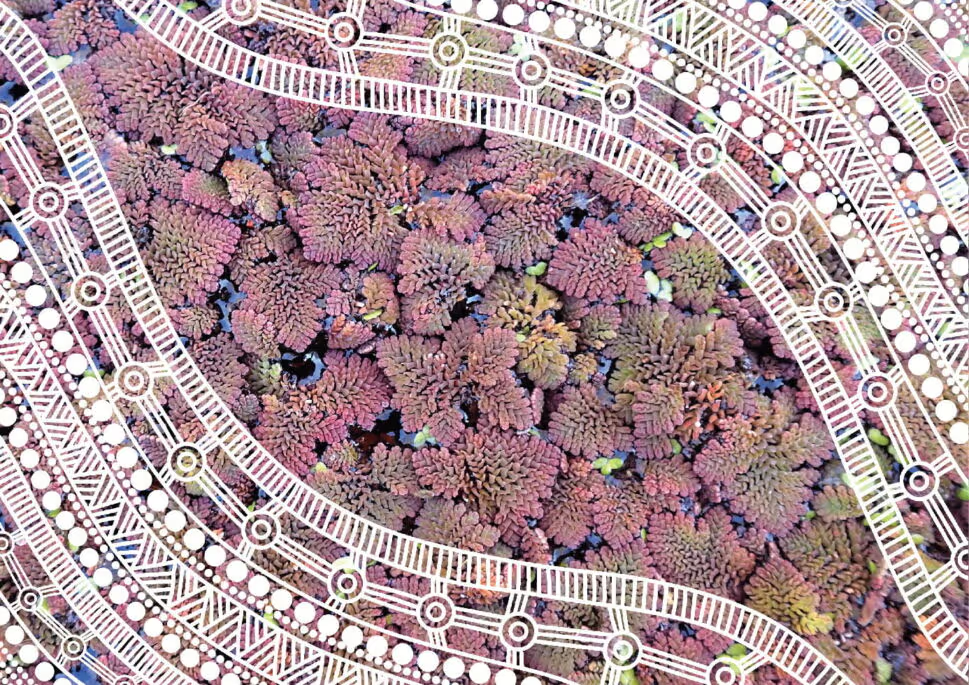Proud Aboriginal woman, Ashleigh Pengelly, calls Uranquinty (15 km south of Wagga Wagga) home and is the creator, CEO and artist behind Little Black Duck Homewares. Born and raised on Wiradjuri Country, Ashleigh’s Aboriginal heritage comes from her matriarchal side, with family ties around Wagga Wagga, Leeton, Robinvale and Echuca with grandmother, Eunice Higgins hailing from Balranald on Mutthi Mutthi Country. The Murrumbidgee Monitoring, Evaluation and Research (MER) team at Charles Sturt University got in touch with Ashleigh to commission artworks for their annual water year calendar, and the result is just beautiful.
The theme of ‘wetlands up-close’ zooms into unusual views of wetland creatures such as a close-up of the eye of a Southern bell frog or the intricate patterns and colours of the aquatic plants such as azolla and swamp lily. Ashleigh’s artworks in the calendar are inspired by the photos taken during wetland monitoring along the Murrumbidgee Catchment area.

Ashleigh’s artworks revolve around connection, community and bridging the gap between Indigenous and non-Indigenous Australians. She is inspired by other artists who use their work as a platform for advocacy, building connection and community. Ashleigh’s signature products are her hand-painted teapots which she says “in the Aboriginal community when we sit down for a yarn, a cuppa tea is the first thing that comes to mind and so I like to use that as a way to share my culture into non-Aboriginal peoples’ homes and to start important conversations around the table.” In the same way that Ashleigh’s teapots are bridging the gap through conversation provoked by art, we hope that this 2023-24 water year calendar can do too, not just for cultural gaps but also the gap between research and community.
Indigenous art is often a form of storytelling. Visual documentation such as cave drawings and rock drawings were a way to record and share history and messages. Materials that were used in everyday life included what was available in the natural landscape. This included tools for painting and resources such as ochre for paint. Ashleigh used digital art to produce the series in the water calendar, but she continued to hold onto those traditional practices where possible through putting the meaning into her artworks and creating with intention as well as using what she sees and feels to guide her art.
“I feel there is often a lot of pressure on Indigenous artists to include meaning and context in our artworks, but often I’m looking out my windows and using the environment around us to inform my works. I allowed every image [in the calendar] to convey its own message, each have their own story, that’s why I specifically chose different styles for each month, so they each have their moment.” Ashleigh had to practice her constraint and use just white as an overlay on the close-up of azolla, allowing the pinks and purples of this free-floating aquatic plant to shine.

Symbols which Ashleigh has used in her work, and are often seen in Indigenous art, include representations of community and connectivity. Here they might mean a swamp or a meeting place, or even a gathering of frogs.


Native flowers such as the swamp lily can be found in wetlands in the Murrumbidgee Catchment area. In this image, a native wildflower sits alongside a flowing stream with ripples across the water.

Dragonflies have a larval stage which require water and, as such, they will often be found mating or feeding near wetlands and streams. Ashleigh is drawn to dragonflies and the freedom of movement they represent. They also represent connectivity, as where there is one dragonfly, there is often another.

Through the Flow-MER program, the Commonwealth Environmental Water Holder works with scientists, water managers and communities across the Murray-Darling Basin to better understand how fish, birds, frogs, vegetation and river connectivity are responding to water for the environment. The water year calendar is an annual publication by the Murrumbidgee MER team at Charles Sturt University which helps bridge the gap between science and community, sharing aspects of freshwater research and hidden gems of the Murrumbidgee Catchment area.




.JPG)

.webp)